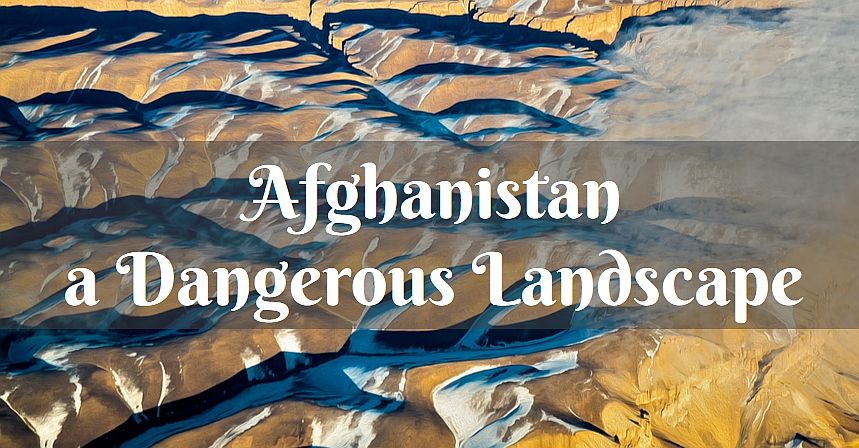Much or less is known about Afghanistan and its dangerous landscape. An old Afghan proverb says: ‘There is a path to the top of even the highest mountain.’ Of course there is, and a view to go with it. A history lesson too, I would add.
Jalalabad to Kabul National Highway, Afghanistan, a tarred dangerous landscape
This road is on World Health Organization’s list of dangerous roads


The 65-km stretch from Jalalabad to Kabul , also known as National Highway 08 (NH08), loops through Taliban territory and the Kabul gorge, the Tang-e Gharu gorge. Speaking of being trapped between Scylla and Charybdis.
But it’s not the threat of insurgency that makes Highway 1 so dangerous — it’s a combination of the narrow, winding lanes that climb up to 600 m through the Kabul gorge.
‘The highway snaked through the deadly desert, a ribbon of asphalt put there by the U.S. army as an illusion of U.S. soil under the tires, secure and everlasting.’
Silent Heroes by Patricia Furstenberg
The remote Wakhan Corridor, Afghanistan, a geographical dangerous landscape


On the North-West of Afghanistan a narrow, looking like a dagger, protrudes into neighboring China and separates the two more adjacent neighbors, Tajikistan from Pakistan. It is the Wakhan Corridor and the most remote place you can think of in Afghanistan, complete with wild river crossings, long slogs up steep mountains and many miles of beautiful single-track.
Although the terrain is extremely rugged, the Corridor was historically used as a trading route between Badakhshan and Yarkand (east and west). It appears that even Marco Polo traveled this way.
Noshaq – Afghanistan’s highest peak


At 7 492 m (24,580 ft) Noshaq is Afghanistan’s highest mountain peak and is part of the Hindu Kush Range, this 800 km mountains stretching at the north of Afghanistan like the spine of a sleeping dragon. Noshaq (also called Nowshak or Nōshākh) may be the highest peak in Afghanisatn, but the highest peak of the Hindu Kush Range is Tirich Mir (at 7,492 m, 24,580 ft) located in Pakistan.
After the Soviet invasion of Afghanistan in 1979, mountaineers stopped visiting Noshaq because of the dangerous political climate. The laying of landmines in Noshaq Valley during the country’s civil war in the 1990s further isolated the enormous mountain.
The alluring Durand Line, a political dangerous landscape
The Durand Line is the 2,640-kilometer (1,640-mile) border between Afghanistan and Pakistan established in 1893 for political reasons. It is the result of an agreement between Sir Mortimer Durand, the secretary of the British Indian government at the time, and Abdur Rahman Khan, the emir of Afghanistan. The agreement was signed on November 12, 1893, in Kabul, Afghanistan. When the Durand Line was created Pakistan was still a part of India. India was in turn controlled by the United Kingdom. The United Kingdom ruled India from 1858 until India’s independence in 1947. Pakistan also became a nation in 1947.


The Durand Line is a historic, much disputed border that separates Afghanistan and Pakistan nations and families.
‘You want to ask why they don’t close the border, Marine? Think of the U.S. southern border, of Germany’s borders during the Communist Bloc and, lately, the North-Korean border. Could those be closed? Has the Durand Line, cutting through Pashtun and Baloch tribal areas, worked?
‘There is a natural flow of movement between Pakistan and Afghanistan that does not pose a threat to any of the two countries. Nor does it pose a threat to regional security and stability. It is the transhumance. The pastoral nomadism of livestock between fixed summer and winter pastures found on both sides of the Pakistan – Afghan border means that shepherds need to feed their livestock in winter to keep their families alive. And these families, residing on both sides of the border, feel stronger about their ethnicity then they do about their nationality.’
Silent Heroes by Patricia Furstenberg
Afghanistan’s Highway 1, the Ring Road, the Afghan Highway to Hell
Afghanistan’s H1 is a 2,200 kilometer nationwide highway network circulating Afghanistan. The road is extremely dangerous because of Taliban and insurgent attacks and ambushes, of roadside bombs as well as extreme weather conditions. Although police checkpoints are scattered along the road and patrols are sent out daily to secure portions of the highway when NATO convoys pass, roadside bombs and ambushes make Highway 1 one of the most dangerous roads in the world.


‘Both Smit and Welsh were part of a critical security unit operating at the nearby notorious bridge where AH1, Afghanistan’s Highway 1 or the Ring Road, crossed over the Helmand River. During the past ten years of war, Taliban ambushes and shrewdly placed IEDs have killed hundreds of troops and innocent civilians in this specific location. Every stop and search had the potential to become a lethal one for the soldier on duty, as performing searches on suspicious looking vehicles had a high potential to turn lethal, while pedestrian body search was something Muslims felt highly against. To help alleviate the situation the army introduced female soldiers in these checkpoints, their job being body searching Muslim women they estimated as suspicious looking.’
Silent Heroes by Patricia Furstenberg
I will end with one last quote from my latest novel, Silent Heroes.
‘‘You know how they call Afghanistan?’
A ‘highway of conquests and the graveyard of empires’ because so many military campaigns conquered the world and arrived here to fail.’
Silent Heroes by Patricia Furstenberg


Interesting description and photos of this beautiful & dangerous landscape!
Thank you Phil. 🙂
I am glad it made a positive impression on you.
NH08 is terrifying! Makes my breath seize just looking at the photo.
I know, I felt the same!
Although Afghanistan’s H1, although on flat terrain, can be just a dangerous because of Taliban’s surprise ambushes and shrewdly placed IEDs planted under the cover of the night.
I enjoyed learning more about this country. I find it fascinating. And that dangerous road!? I’d be paralyzed with fear. Lol. Thanks for sharing.
I, too,would be scared to drive there! Feeling thankful for good and safe roads.
Thank you for visiting, Diana 🙂
Deadly beauty!
Ah, so well said, Mark!
Thank you.